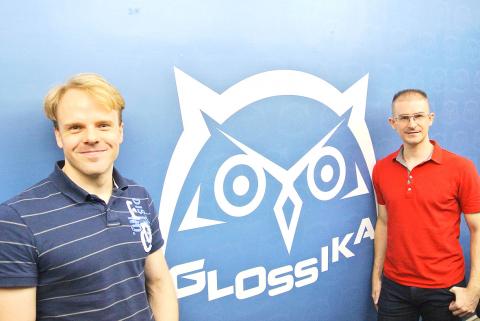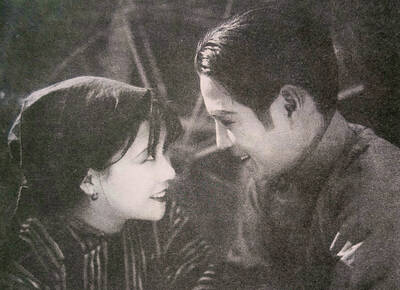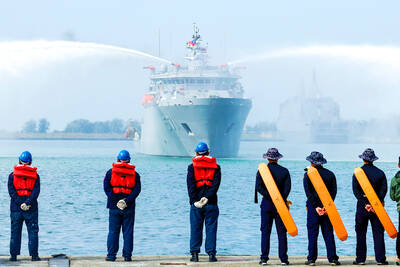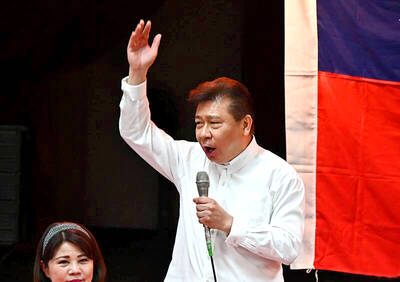Out of his Taipei office, American expatriate Mike Campbell creates downloadable self-study language kits for a global market.
The product, Glossika, is a bit like Rosetta Stone, offering spaced repetition exercises in English, Mandarin, Spanish and other common languages of the world. Unlike Rosetta Stone, Glossika has also begun developing courses for Taiwan’s ethnic and minority languages.
He is planning a kit for Hakka in cooperation with the Hakka Affairs Council (客家委員會), as well as for endangered languages like Amis, Atayal, Puyuma, Rukai, Sediq, Tao, Thao and Truku.

Photo courtesy of Glossika
Released last week, Campbell’s first Taiwan-based course teaches English speakers the language of Hoklo, also known as Taiwanese and one of the Minnan dialects spoken by about 75 percent of the country’s population.
Minnan is a tonal language that branched off from Chinese in the time of Confucius, about a thousand years earlier than Cantonese and Hakka did, Campbell said.
Because it is so old, Minnan retains final palatal endings that today exist elsewhere only in early borrowings of Chinese words in Vietnamese.
Also due to its age, Minnan has a capaciously diverse vocabulary. For example, the Minnan word for beautiful, sui, is cognate with the word suay in the Thai language.
“This language is so old that parts of its vocabulary are Austric or Austronesian. It goes back so far in time when those languages were still developing,” he said.
TAIWAN MINNAN (hoklo)
Minnan was first spoken in what is now Guangzhou and the southeast coast of present-day Fujian province, but today it is also used in Taiwan, Singapore, Malaysia and the Philippines with different intonations that are mutually intelligible.
Campbell’s program teaches Hoklo, a variant of Minnan spoken in Taiwan, featuring voice recordings by Tsan Ik Hian (曾弋軒), a graduate student at Taiwan Normal University’s Department of Taiwan Culture, Languages and Literature (師大台灣語文學系).
“The standard Taiwanese Minnan is different from the version in Fujian due to Japanese colonialization and influences from now-extinct Pingpu Aboriginal tribes. For example, bala (guava) is borrowed from the Aborigines,” Tsan said.
Hoklo also changed during decades of Martial Law era policies that actively phased out its use in favor of Mandarin.
Today, young speakers do not pronounce Hoklo in the standard Taiwanese dialect, but tend to drop the final sounds of syllables, she said.
Tsan, 25, is a native of Greater Tainan who speaks Hoklo in a clear lilting voice.
She is one of the few Hoklo speakers who know and habitually write with tailo (台羅), a romanization system developed by Taiwan’s Ministry of Education in the 1990s.
Hoklo does not have a standard writing system of its own, Campbell said.
Instead, Minnan speakers across history have sometimes used peh-oe-ji, an orthography that missionaries from the West developed in the 19th century.
In Taiwan, some speakers have mastered tailo, but most use Chinese characters idiosyncratically to represent spoken Minnan.
A MORIBUND LANGUAGE
Campbell is developing kits for other languages of Taiwan including Thao, which today has only five living speakers.
The Thao Aboriginal people, who live near Sun Moon Lake, have a dwindling population of around 300. Most are fluent in Mandarin and Minnan but not Thao.
Thao is a 7,000-year-old language with few words for modern technology and a rich and granular vocabulary for plants, animals and other aspects of the physical world.
Two in the tiny cohort of fluent speakers are an elderly couple that Campbell visits in their village for chats. He carefully documents the fine points of lexicon and grammar as his hosts talk and pour tea and the sun sets over their lakeside valley.
“I love the sound. It is very easy to express yourself in this language,” Campbell said.
“It gives you a sort of sense, connection with the earth, nature, history.”
For Campbell, providing minorities access to majority languages can help them substantively improve their lives. Promoting a minority language helps its marginalized speakers survive and be discovered by the world.
“Many of those people are still living here in Taiwan. You just have to find them,” he said.

March 10 to March 16 Although it failed to become popular, March of the Black Cats (烏貓進行曲) was the first Taiwanese record to have “pop song” printed on the label. Released in March 1929 under Eagle Records, a subsidiary of the Japanese-owned Columbia Records, the Hoklo (commonly known as Taiwanese) lyrics followed the traditional seven characters per verse of Taiwanese opera, but the instrumentation was Western, performed by Eagle’s in-house orchestra. The singer was entertainer Chiu-chan (秋蟾). In fact, a cover of a Xiamen folk song by Chiu-chan released around the same time, Plum Widow Missing Her Husband (雪梅思君), enjoyed more

Last week Elbridge Colby, US President Donald Trump’s nominee for under secretary of defense for policy, a key advisory position, said in his Senate confirmation hearing that Taiwan defense spending should be 10 percent of GDP “at least something in that ballpark, really focused on their defense.” He added: “So we need to properly incentivize them.” Much commentary focused on the 10 percent figure, and rightly so. Colby is not wrong in one respect — Taiwan does need to spend more. But the steady escalation in the proportion of GDP from 3 percent to 5 percent to 10 percent that advocates

From insomniacs to party-goers, doting couples, tired paramedics and Johannesburg’s golden youth, The Pantry, a petrol station doubling as a gourmet deli, has become unmissable on the nightlife scene of South Africa’s biggest city. Open 24 hours a day, the establishment which opened three years ago is a haven for revelers looking for a midnight snack to sober up after the bars and nightclubs close at 2am or 5am. “Believe me, we see it all here,” sighs a cashier. Before the curtains open on Johannesburg’s infamous party scene, the evening gets off to a gentle start. On a Friday at around 6pm,

A series of dramatic news items dropped last month that shed light on Chinese Communist Party (CCP) attitudes towards three candidates for last year’s presidential election: Taiwan People’s Party (TPP) founder Ko Wen-je (柯文哲), Terry Gou (郭台銘), founder of Hon Hai Precision Industry Co (鴻海精密), also known as Foxconn Technology Group (富士康科技集團), and New Taipei City Mayor Hou You-yi (侯友宜) of the Chinese Nationalist Party (KMT). It also revealed deep blue support for Ko and Gou from inside the KMT, how they interacted with the CCP and alleged election interference involving NT$100 million (US$3.05 million) or more raised by the